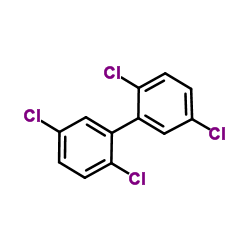2,2',5,5'-PCB

2,2',5,5'-PCB structure
|
Common Name | 2,2',5,5'-PCB | ||
|---|---|---|---|---|
| CAS Number | 35693-99-3 | Molecular Weight | 291.988 | |
| Density | 1.4±0.1 g/cm3 | Boiling Point | 344.9±37.0 °C at 760 mmHg | |
| Molecular Formula | C12H6Cl4 | Melting Point | 87℃ | |
| MSDS | Chinese USA | Flash Point | 161.9±23.9 °C | |
| Symbol |




GHS02, GHS07, GHS08, GHS09 |
Signal Word | Danger | |
|
Temporal trends of selected POPs and the potential influence of climate variability in a Greenland ringed seal population.
Environ. Sci. Process. Impacts 15(9) , 1706-16, (2013) Temporal trends of selected POPs (PCB-52 and 153, p,p'-DDE, HCB, α- and β-HCH) in blubber of ringed seals (Pusa hispida) collected from the early 1990s to 2010 from central West Greenland were studied. In this period, the climate of Greenland warmed and the i... |
|
|
Vertical distributions of organochlorine pesticides and polychlorinated biphenyls in an agricultural soil core from the Guanzhong Basin, China.
Environ. Monit. Assess. 187(1) , 4159, (2015) The concentrations and distributions of hexachlorocyclohexanes (HCHs), dichlorodiphenyltrichloroethanes (DDTs), and polychlorinated biphenyls (PCBs) in an agricultural soil core in the Guanzhong Basin, China were determined. Overall, p,p'-DDT and p,p'-DDE wer... |
|
|
Dopamine-dependent behavior in adult rats after perinatal exposure to purity-controlled polychlorinated biphenyl congeners (PCB52 and PCB180).
Toxicol. Lett. 224(1) , 32-9, (2014) Since knowledge about toxic effects of non-dioxinlike (NDL) PCBs is fragmentary, regulatory panels have concluded that risk assessment of these congeners is hampered or impossible. As the dopaminergic system is one of the main targets in PCB-related neurotoxi... |
|
|
Apoptosis in bovine cumulus-oocyte complexes after exposure to polychlorinated biphenyl mixtures during in vitro maturation.
Reproduction 130(6) , 857-68, (2005) Aroclor-1254 (A-1254) is a commercial mixture of coplanar (dioxin-like) and non-coplanar (non dioxin-like) polychlorinated biphenyls (PCBs) affecting bovine oocyte in vitro maturation (IVM) and developmental competence. In the present study, the role of cumul... |
|
|
Serum concentrations of indicator PCB congeners in the Czech adult population.
Chemosphere 72(8) , 1124-31, (2008) In 2006, levels of seven indicator polychlorinated biphenyl congeners (PCB28, 52, 101, 118, 138, 153, and 180) in blood serum of 202 blood donors residing for more than 2 years in five urban areas included in the Czech Human Biomonitoring project were measure... |
|
|
Biological monitoring of indoor-exposure to dioxin-like and non-dioxin-like polychlorinated biphenyls (PCB) in a public building.
Toxicol. Lett. 213(1) , 116-21, (2012) The release of PCBs from sealant material in public buildings and the resulting indoor air levels have raised growing concerns about possible human health effects connected with this exposure. Ambient monitoring of PCBs in a public building has revealed a con... |
|
|
Pesticide contamination profiles of water, sediment and aquatic organisms in the effluent of Gaobeidian wastewater treatment plant.
Chemosphere 72(8) , 1145-51, (2008) Organochlorine pesticides (OCPs, including DDT, HCH and HCB) and six indicator polychlorinated biphenyls (PCB 28, 52, 101, 138, 153, and 180) were measured in water, sediment, zooplankton, fish and Chinese softshell turtle (Pelodiscus sinensis) from Gaobeidia... |
|
|
Postnatal exposure to PCB 153 and PCB 180, but not to PCB 52, produces changes in activity level and stimulus control in outbred male Wistar Kyoto rats.
Behav. Brain Funct. 7 , 18, (2011) Polychlorinated biphenyls (PCBs) are a class of organic compounds that bioaccumulate due to their chemical stability and lipophilic properties. Humans are prenatally exposed via trans-placental transfer, through breast milk as infants, and through fish, seafo... |
|
|
Studying placental transfer of highly purified non-dioxin-like PCBs in two models of the placental barrier.
Placenta 32(3) , 283-91, (2011) Currently, toxicology and toxicokinetics of purified non-dioxin-like polychlorinated biphenyls (NDL-PCBs) are poorly characterised. Transplacental kinetics of NDL-PCBs can be studied in a variety of models, but careful validation of each model is crucial. We ... |
|
|
Differential long-term effects of developmental exposure to polychlorinated biphenyls 52, 138 or 180 on motor activity and neurotransmission. Gender dependence and mechanisms involved.
Neurochem. Int. 58(1) , 69-77, (2011) Developmental exposure to polychlorinated biphenyls (PCBs) induces motor alterations in humans by unknown mechanisms. It remains unclear whether: (a) all non-dioxin-like (NDL) PCBs are neurotoxic or it depends on the grade of chlorination; (b) they have diffe... |